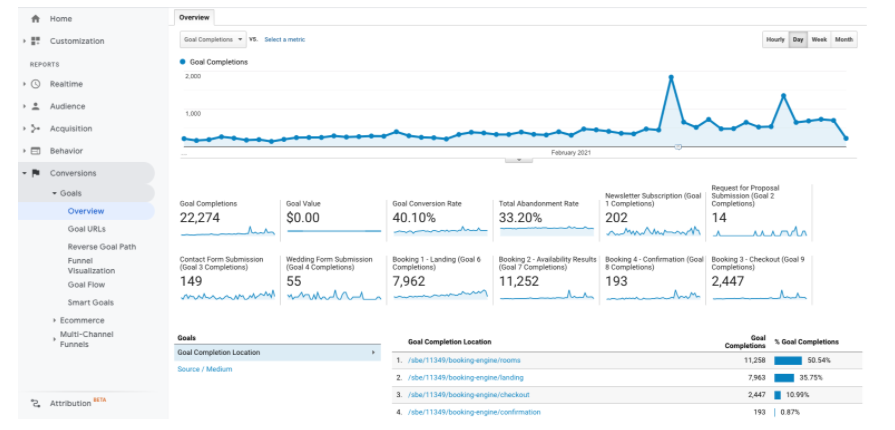
The road to a successful content marketing strategy is paved with key performance indicators (KPIs). But if you’ve ever tried to measure the performance of your content, you probably know those KPIs are as likely to lead you down a dead end as they are to send you across the finish line.
So how can your approach to content marketing analytics actually help you measure, and even replicate, success?
#1 – Don’t get hung up on vanity metrics
There are a seemingly infinite number of KPIs in the world of marketing. Whether you use Google Analytics, Adobe Analytics, or other analytics tools, each will offer a mountain of numbers intended to measure the who, how, when, and where of users’ engagement with your website.
That mountain could be a gold mine, but it could also be a haystack obscuring a very elusive needle.
Content marketing metrics like session duration, time on page, pages per session, and bounce rate do give you a vital insight into how users’ interacted with your content. But they fall short in illuminating how a user felt about your content. More importantly, they also miss whether or not your content actually moved that user further down the path to purchase.
What does the amount of time a user spent reading your blog posts tell you about whether or not that user is closer to buying what you’re selling? Does the fact that they didn’t bounce mean that they’re ready for the hard sell of your remarketing list? In a vacuum, no single KPI can answer these questions.
This is why we recommend adopting a custom approach. Layering what would otherwise be vanity metrics with custom segments will tell you so much more about the success of your content. How long did certain segments spend reading content compared to others? What was your most valuable segment? Can you learn something from one successful segment to apply to a segment that may be underperforming?
To create these segments, start by implementing custom events and goals.
#2 – Do create Google Analytics events and goals
A user could spend an entire day reading your pieces of content. But if that user doesn’t become a customer, all that time might not tell you anything about the efficacy of your content marketing program. This is where events and goals come in.
Custom Events
Custom events allow you to track user actions. These are actions that do not contribute to your revenue and are not views to a specific page. Examples include clicking an internal link, watching a video, or tapping a button.
Google Analytics allows you to track up to 500 events, and these events can be triggered multiple times in the same session. Setting up strategic events will help you pinpoint the site content receiving a lot of engagement as well as where you might need to make some changes to better draw the user in.

Custom events are also a great place to start when segmenting your audience. Setting up events will allow you to create what is essentially a data profile for each of the events you set up.
If, for example, you created an event to capture users who searched for certain dates of stay, you could also create a segment of those users to understand what path they took through your website to get there. This, in turn, allows you to create content that guides users through the same steps.
Goals
Goals measure conversion events on your website. Though a “goal” is often interpreted as purchases, goals can be both macro and micro. Macro conversions include providing contact information via gated content or reaching a confirmation page, whereas micro-conversions are events like signing up for a newsletter or viewing a high-value page.
Google Analytics allows for up to 20 goals, so choose wisely. Once your goals are set up, you can also create funnels for each goal that will reveal where users are dropping off your site. You can then optimize accordingly.
By setting up events and goals specific to your site, you’ll uncover more tailored insights into whether or not your content marketing is working. Stop settling for vanity metrics and instead seek to answer questions like: Are blog readers taking actions that matter to my business? How did my blog post move users further towards a purchase? What are blog readers doing (or not doing) after they read a certain post?

#3 – Don’t Jump Straight to Tactics
Many marketers will start with tactics. They’ll be readying to deploy their Facebook ads or publish a series of blog posts at the drop of a hat. This is understandable.
Google marketing best practices and you’ll find countless articles recommending new traffic sources, types of content, or supposedly cutting-edge content marketing efforts. Resist the urge to implement every tactic under the sun.
Just because a tactic worked for one brand, doesn’t mean it’ll work for yours. And if it does end up working for your brand, that success may not be replicable if you’re not exactly sure why it worked.
The “why” is critically important to the long-term success of your marketing program. That’s why we always recommend working forward from your goals when choosing content marketing metrics.
#4 – Do Set Measurable Goals
Setting goals can feel daunting. After all, these are the big ideas that drive not only your marketing choices but also your entire business. Many of our own clients aren’t sure at first what their goals are, especially if the only question we ask them is, simply, “what are your goals?”
However, whether you’re the one setting your goals, you’re asking your boss, or you’re working with a trusted partner, consider questions like these:
- What outcomes matter to the business?
- What does success look like?
- What do you want out of your website?
Answers to these questions will likely come a lot more quickly than if you get hung up on the word “goal.” Use these answers to craft goal statements that you can fit into your marketing program.
From there, delve into your data to find the most likely way you can achieve that outcome. This is your strategy. Determine how you can measure whether or not you’re getting closer to that outcome. These are your objectives. And then, only, then, identify tactics that can be measured by your objective, fit within your strategy, and will stack up to achieving your goals.
Doing this will not only improve the efficacy of your content marketing program, but it will also streamline your approach to analytics. All content analytics can now be delivered and discussed within the framework of that documented outcome. No more haggling over session duration and page views.
#5 – Don’t Rely on Third-Party Data Tools
Attribution is complex. Whether you rely on last-click, multi-touch, or something more proprietary, chances are you’ve had a hard time proving the ROI for anything outside of your paid channels.
Your tech stack probably includes ad platforms, Google Analytics or another tracking tool like Adobe Analytics, CRMs, and even a marketing automation system. Each tool stores its data separately. These silos can make it nearly impossible to understand how each touchpoint contributes to someone becoming a customer.
What’s worse, these tools have their own motivations for packaging your data the way they do. After all, you don’t own that data. They do. And if you’re an ad-serving platform that makes money on ad spend, where would you attribute the majority of a website’s success? The ads they pay for or the organic traffic they don’t?
Moreover, what if you discover a data tool that better meets the need of your future content? You can almost guarantee that you’ll have to leave your historical data behind in the transition. But data tools like these aren’t your only option.
#6 – Do Take Steps to Own Your Own Data
Content marketing as a strategy is based on the adage that you shouldn’t build a house on rented land. If you lose the land, your house will go with it. Yet many brands settle for data solutions they don’t actually own.
Changes in tracking, the evolution of the market, or simply the discovery of a new tool could cause a brand to lose its historical data at the drop of a hat. But many companies don’t realize there’s another way.
At Screen Pilot, we encourage our clients to take steps towards owning their own data. According to DreamData.io, this process requires three main steps:
- Find software that allows you to own your own data
- Be able to move your data around and out of the systems as you see fit
- Store your data in your own database
We recommend storing data in Google BigQuery, but there are other storage options broadly referred to as “Customer Data Platforms,” which are what DreamData describes as “a data warehouse solution that stores all your customer data touchpoints.
”With all your data from multiple sources aligned in one place, you can start to create more streamlined customer profiles. You’re in control of the story, which means you can better connect the user journey and create an attribution model that’s specific to your business.
If you’ve ever wondered whether you can tie revenue to content, this is also the best way to do that.
When you own and manage your own data, you can more effectively map what users did in the sessions prior to their transaction and finally give credit where credit is due.
Did you enjoy the read?
Get original hospitality industry insights delivered to your inbox. Sign up to receive Screen Pilot’s #TrendingNow Newsletter.






